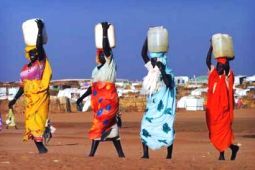Darfur, a region mired in conflict
April 28, 2006 (KHARTOUM) — Darfur, a vast arid region of Sudan the size of France, has been wracked by civil war since February 2003 causing one of the world’s worst humanitarian catastrophes.
 Bordering Chad and Libya in northeastern Africa, Darfur has a population of six million and was formerly a sultanate until 1917 when it was incorporated into Sudan, then ruled by Britain.
Bordering Chad and Libya in northeastern Africa, Darfur has a population of six million and was formerly a sultanate until 1917 when it was incorporated into Sudan, then ruled by Britain.
The mineral-rich region takes its name from one of the principal African tribes, the Fur people, and the Arabic word “Dar,” meaning home.
The civil war and its consequences have led to the deaths of up to 300,000 people, while the United Nations estimates that more than 2.4 million have been forced from their homes.
US President George W. Bush’s administration considers the conflict genocide and the US-based Human Rights Watch accuses the Khartoum government of ethnic cleansing.
War broke out in Darfur in February 2003 when rebel groups revolted against what they say is the political and economic marginalization of the region’s black African ethnic groups by the Arab-dominated regime in Khartoum.
Khartoum responded by unleashing the Janjaweed militia, a force of mounted gunmen dubbed “devils on horseback”, which has been blamed for many atrocities including murder, rape, looting and burning villages.
The rebellion is being fought mainly by the Sudan Liberation Movement (SLM) and the Justice and Equality Movement (JEM).
The rebel groups are demanding more autonomy and economic development for the black African-populated region which they see as marginalized by Arab Khartoum and have demanded a more equitable distribution of the nation’s resources, especially oil.
A 7,000-strong African Union force was first deployed in 2004 and is currently being largely financed by the United States, Canada and the European Union.
The United Nations however has proposed replacing the under-funded and ill-equipped AU force with UN peacekeepers, something Khartoum has rejected.
On March 31 2005, the United Nations approved a resolution which allowed those responsible for such atrocities to be tried by the International Court of Justice, after long debates linked to US opposition to the tribunal.
The UN Security Council this week imposed a travel ban and economic sanctions on four Sudanese blamed for bloodshed and rights abuses in Darfur, including rebel, government and allied militia leaders.
US President George W. Bush followed suit on Thursday.
The Darfur conflict has no basis in religion with its entirely Muslim and Arabic speaking population of Arab and African tribes, unlike the 21-year civil war of southern Sudan with its majority animist and Christian population.
The population comprises both peasant farmers and nomadic peoples spread over three Sudanese states, West, North and South Darfur, which cover a total of 500,000 square kilometres (200,000 square miles).
The region is mainly one of high plateaus with some desert areas and volcanic summits culminating in the 3,071 metres (10,134 feet) of the highest peak in the Jebel Marra mountains.
There is considerable mineral wealth in the region including oil, uranium and copper while cattle raising is one of the main sources of income.
The region has, for a number of years, been an area of conflict between the nomadic and agricultural tribes with raids by armed groups. However there was no armed political movement in the region until February 2003, when a Darfur Liberation Front emerged, splitting into the SLM and JEM.
The JEM is said to have up to 7,000 men while the armed branch of the SLM has 16,000 fighters. The rebels claim to control all the rural areas while the Sudanese army remains confined, they say, to the main cities in the region.
In February 2004 the SLM joined the ranks of the National Democratic Alliance (NDA), a coalition which groups part of the northern opposition to Khartoum and the southern rebels.
(ST)
